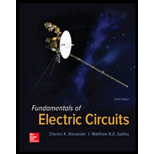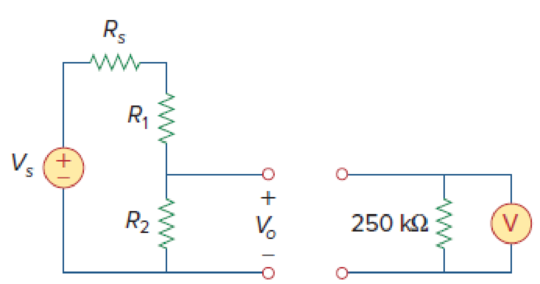
Concept explainers
A voltmeter used to measure Vo in the circuit in Fig. 2.129. The voltmeter model consists of an ideal voltmeter in parallel with a 250-kΩ resistor. Let Vs = 95 V, Rs = 25 kΩ, and R1 = 40 kΩ. Calculate Vo with and without the voltmeter when
- (a) R2 = 5 kΩ
- (b) R2 = 25 kΩ
- (c) R2 = 250 kΩ

Figure 2.129
(a)
Find the values of
Answer to Problem 69P
The values of
Explanation of Solution
Given data:
Calculation:
Case 1: with voltmeter
Refer to Figure 2.129 in the textbook.
When a voltmeter is connected to the circuit,
By using voltage division rule, write the expression for voltage
Substitute
Substitute
Case 2: without voltmeter
As there is no voltmeter is connected, by directly using voltage law, write the expression for voltage
Substitute
Conclusion:
Thus, the values of
(b)
Find the values of
Answer to Problem 69P
The values of
Explanation of Solution
Given data:
Calculation:
Case 1: with voltmeter
Substitute
Substitute
Case 2: without voltmeter
Substitute
Conclusion:
Thus, the values of
(c)
Find the values of
Answer to Problem 69P
The values of
Explanation of Solution
Given data:
Calculation:
Case 1: with voltmeter
Substitute
Substitute
Case 2: without voltmeter
Substitute
Conclusion:
Thus, the values of
Want to see more full solutions like this?
Chapter 2 Solutions
Fundamentals of Electric Circuits
- Given this scenario, If XMM2 is an Ammeter and its reading is 0A, andXMM3 is a Voltmeter and its reading is 10V, What is the state of thetransistor? What is the cause of it? Explain your answer.arrow_forwardListen R₁ *: 22 ΚΩ Vino (a) R₁ ww 150 kQ D out (b) OV out The circuit or circuits with a virtual ground is (c) and (d) (a) (b) (d) all figures represent circuits with virtual ground V out R₁ {82 ΚΩ wwwww R₁ 10 ΚΩ (d) wwwwww OV 343 Rf 33ΚΩ RN out {R₁ 2.7 ΚΩarrow_forwardFind the value of a resistor having the following colors, orange, orange, brown, red? A series-ohmmeter is used to measure the resistance of a given resistor. The ammeter reading is 0.5A, the ammeter resistance is 1.2Ω, the series resistance is 2.4Ω, and the ohmmeter battery is 9V. Draw the practical circuit for this measurement? Find the full-scale deflection? Find the half-deflection resistance of the ohmmeter? Determine the resistance value?arrow_forward
- Determine the equivalent resistance between terminals a and b. R1 R2 1 Ohm 2 Ohms R3 3 Ohms R4 R5 -b 4 Ohms 5 Ohms O 7.6547 0 6.7520 Q O 5.9253 0 6.9130 0arrow_forwardSuppose that the components of the circuit shown in figure below, have the following values: R1= 160 , R2= 182 , R3=302 , R4=92 , R5= 42. The voltage across AB is measured by a voltmeter whose internal resistance is 2502. What is the measurement error caused by the resistance of the measuring instrument? R2 36v T A RM 13 Eo RS R4arrow_forwardA battery with Ɛ = 5.50 V and no internal resistance supplies current to the circuit shown in the figure below. When the double-throw switch S is open as shown in the figure, the current in the battery is 1.00 mA. When the switch is closed in position a, the current in the battery is 1.14 mA. When the switch is closed in position b, the current in the battery is 1.96 mA. R1 R2 S ob (a) Find the resistance R1. (b) Find the resistance R2. (c) Find the resistance R3.arrow_forward
- For the circuit shown below, The current (1) can be calculated as: Vin a. Vin O b. O C. Vin R1 O d. Zero e. R1 Vin R1 + R3 Vin*R1 R1 + R3 13R3 V3arrow_forwarda. All resistors in the given figure are 5ohms each. Find Req. -ww Req b..(a) Calculate current i in the given figure when the switch is in position 1. (b) Find the current when the switch is in position 2 100 £2 ww 15 V 150 £2arrow_forwardvoltage across R has to be measured with a voltmeter. What percentage error is expected in measuring the voltage if R₁=R₂=R3=R₂=R-100 Q for meter resistance of 1500 Q and 15000 Q. Also calculate the percentage error in measuring the current through R, if the ammeter resistance is 15 and 1.5 Q. Assume Eo, lo as true value and Em, Im as measured value. 10: F 20 20 I' R₁ R₂ R3 ARA A Rg J B 1500022 ģiseen 15000arrow_forward
- 0.2 A moving coil instrument gives a half scale deflection for a current of 20 mA with a potential difference of 300 mV across it. Using direct method, calculate and design: i) Shunt resistors are required to use it as an ammeter to get ranges 0 – 50 A and 0- 100 A. ii) Multiplier resistors are required to use it as a voltmeter of ranges 0 – 150 V and 0– 300 v.arrow_forward0.2 A moving coil instrument gives a half scale deflection for a current of 20 mA with a potentiar difference of 300 mV across it. Using direct method, calculate and design: i) Shunt resistors are required to use it as an ammeter to get ranges 0-50 A and 0- 100 A. ii) Multiplier resistors are required to use it as a voltmeter of ranges 0- 150 V and 0- 300 V.arrow_forward12 = ➖➖➖➖➖➖➖➖* + E Si ✈ D₁ 20 V R₂ 5.6 ΚΩ 3.32 mA 3.12 mA 3.55 mA 3.97 MA What is wrong with this circuit? * - V₁ 24 V R₁10 kn D₁ Si D₂ ID₂ 1N4744A 15 V The zener is open. The zener is shorted or damaged not enough data reversed connection of zener diode R₁ 3.3k92 4.790 1₁ R₂2.5 kn RLarrow_forward
 Introductory Circuit Analysis (13th Edition)Electrical EngineeringISBN:9780133923605Author:Robert L. BoylestadPublisher:PEARSON
Introductory Circuit Analysis (13th Edition)Electrical EngineeringISBN:9780133923605Author:Robert L. BoylestadPublisher:PEARSON Delmar's Standard Textbook Of ElectricityElectrical EngineeringISBN:9781337900348Author:Stephen L. HermanPublisher:Cengage Learning
Delmar's Standard Textbook Of ElectricityElectrical EngineeringISBN:9781337900348Author:Stephen L. HermanPublisher:Cengage Learning Programmable Logic ControllersElectrical EngineeringISBN:9780073373843Author:Frank D. PetruzellaPublisher:McGraw-Hill Education
Programmable Logic ControllersElectrical EngineeringISBN:9780073373843Author:Frank D. PetruzellaPublisher:McGraw-Hill Education Fundamentals of Electric CircuitsElectrical EngineeringISBN:9780078028229Author:Charles K Alexander, Matthew SadikuPublisher:McGraw-Hill Education
Fundamentals of Electric CircuitsElectrical EngineeringISBN:9780078028229Author:Charles K Alexander, Matthew SadikuPublisher:McGraw-Hill Education Electric Circuits. (11th Edition)Electrical EngineeringISBN:9780134746968Author:James W. Nilsson, Susan RiedelPublisher:PEARSON
Electric Circuits. (11th Edition)Electrical EngineeringISBN:9780134746968Author:James W. Nilsson, Susan RiedelPublisher:PEARSON Engineering ElectromagneticsElectrical EngineeringISBN:9780078028151Author:Hayt, William H. (william Hart), Jr, BUCK, John A.Publisher:Mcgraw-hill Education,
Engineering ElectromagneticsElectrical EngineeringISBN:9780078028151Author:Hayt, William H. (william Hart), Jr, BUCK, John A.Publisher:Mcgraw-hill Education,





